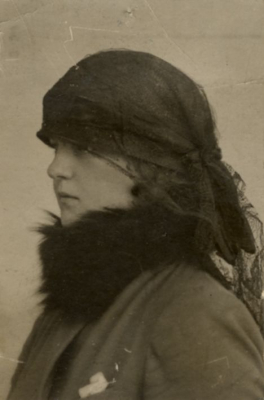“The Latvian Mata Hari”, “an adventurous woman”, “one of the most intellectual women in Latvia” – that is what people said about the writer and journalist Austra Ozoliņa-Krauze (1890–1941). She is a fascinating person in the history of Latvian culture, but there are still a lot of “blank spots” in her biography.
Austra Ozoliņa-Krauze was born in Riga on 30 November 1890. Her father was a building contractor, and so she could afford to study abroad. From 1912 until 1917, she studied philology and law at the University of Bern in Switzerland. That is when Austra began her active socio-political and publicist work. She became the editor of the magazine Latvians Abroad, which was published in Basel. Austra wrote articles for English, French, Italian and Swiss newspapers and released brochures in English, French and German about the political and cultural aspects of Western Europe, Latvia and Russia. From 1916 until 1919, Austra Ozoliņa-Krauze directed the Latvian Propaganda Bureau in Switzerland, and that attracted the attention of espionage services. She was followed by representatives of Switzerland’s secret service. Her propaganda against Germans was so impressive that it was even discussed at the German Embassy in Bern.
In 1921, Austra Ozoliņa-Krauze, who was one of Latvia’s first female diplomats, returned to Riga. Soon after her arrival, she met Aleksandra Beļcova, who had recently moved to Latvia. For the next decade, Austra became a close friend and financial supporter of the artist.
The first project which Austra supported was the political and satirical magazine Ho-Ho, which was produced by artists. The magazine was published from 1922 until 1924, and feuilletons and articles were published by the most visible Latvian writers and poets of that era. Illustrations and cartoons for the magazine were mostly drawn by members of the Riga Group of Artists, including Aleksandra Beļcova and Romans Suta, as well as other young artists. They were paid for their work, though it is not known whether Austra paid them or attracted financing for the process.
In 1924, Austra Ozoliņa-Krauze provided support to the Baltars porcelain painting workshop. She owned a building at Lāčplēša Street 23 where there was a workshop and salon at which artists sold their work. They all lived in that building — Austra, Aleksandra Beļcova with Romans Suta, and Sigismunds Vidbergs with his family.
In the secod half of the 1920s, thanks to the help of her friend, Beļcova managed to visit one of the best clinics in Europe for tuberculosis patients. It was in Southern France. Aleksandra and Austra were literally inseparable at that time, and it is no accident that Austra is seen as a unique alter ego in Beļcova’s self-portraits.
Not only Beļcova was inspired by the French Riviera, which is seen in many paintings and drawings. In Vence, Austra rented a villa and wrote her first novel, In the Revolving Door. It was published in 1929, and Romans Suta designed the cover for the book. The book was about the Hôtel de Paris in Monte Carlo and its casino and restaurants. Austra often visited the hotel and probably found inspiration for the characters in her book – a rich American factory owner, poor Russian emigrant aristocrats, and elderly marquise and a Black guard at the glassed revolving door. Also while she was at the French Riviera, Austra released a play Catherine. It was an historical comedy about the czarina of Russia, who was the wife of Peter the Great.
Gambling was a problem for Austra Ozoliņa-Krauze, and financial difficulties began in 1926. That is when the press started to report that many of her things were being auctioned by court bailiffs. Soon she had to sell the house that she had inherited from her father, but nonetheless, Austra was officially declared bankrupt in 1929.
During the 1930s, Austra Ozoliņa-Krauze spent more time abroad than in Latvia – in Amsterdam, France and Spain. Austra’s passionate nature and her yearning for adventures and risk led her to become involved in various questionable projects, perhaps also because she was deeply in debt. Much is unknown about this period in her life. It really was a time when Austra began to work closely with special services.
Austra Ozoliņa-Krauze was a woman with a complicated personality. Thoughts can differ about her achievements in journalism and literature, but unquestionable is her role as a guardian angel in the life of Aleksandra Beļcova. The paintings and drawings of Austra can be seen as a form of thanks from the artist, and these portraits recorded Austra’s name in the history and culture of Latvian art.
The exhibition presents portraits of Austra Ozoliņa-Krauze, her documents, photographs and manuscripts from the collections of the Museum of Literature and Music, the Romans Suta and Aleksandra Beļcova Museum, Latvian National Museum of Art, as well as private collections.
Gallery name: Museum of Romans Suta and Aleksandra Beļcova
Address: Elizabetes iela 57a, Apt. 26 Rīga, Riga
Opening hours: Tue 11:00 - 19:00, Wed-Sat 11:00 - 18:00
Open: 07.07.2020 - 30.01.2021







